
Gotenhafen, Korridor & North Atlantic.
From the Beginning - - - to the End - - - 1938 - 1945.
Danzig's Westerplatte War extends around the World;
Case White:
With Nazi Party rule in Danzig, many Polish import-export firms made theire move to Gdynia. Whereas total tonnage passing through Gdynia was rising constantly, Danzig's share of Poland's sea-going trade was dropping. {7} However, it was only on September 1st, 1939, that the competition between the city with a thousand-year shipping history and the upstart just down he coast came to an end.
After the conquest of Poland, Hitler announced on October 8th, 1939, the creation of the Reichsgau Danzig--West Prussia. The graeter part of the Reichsgau, incluiding the city of Gdynia, was formed by the Polish province of Pomorze, the northern segment of the Polish corridor. The port of Gdynia was now jointly administered with Danzig's harbour, although the reorganization had little practical significance during a war that brought commercial shipping virtually to a standstill.
How Gotenhafen Received Its Name :
Despite little real evidence to support the assertion, Adolf Hitler beleved that Gdingen (Gdynia) had been ancient "hafen" of the "Goten" (Goths). On September 19th, 1939, probably as a direct command of Hitler, Gdingen officially became known as "Gotenhafen". It was reported that Hitler was shown a photograph by Gauleiter Albert Forste on that day at Gau headquarters in Danzig of an allegedly Germanic face on an urn discovered near Gdingen.
During Hitlers's visit to Gotenhafen on September 21st the new name was placed on public display. The photograph (Figure 4) is of the civil administratiojn building and had been taken on September 21st.
. . . .
Danzig Study Group U.S.A.
Danzig Report Nr. 155 - January - February - March - 2012, Page 15.
Hits: 2054
Added: 04/03/2012
Copyright: 2024 Danzig.org

